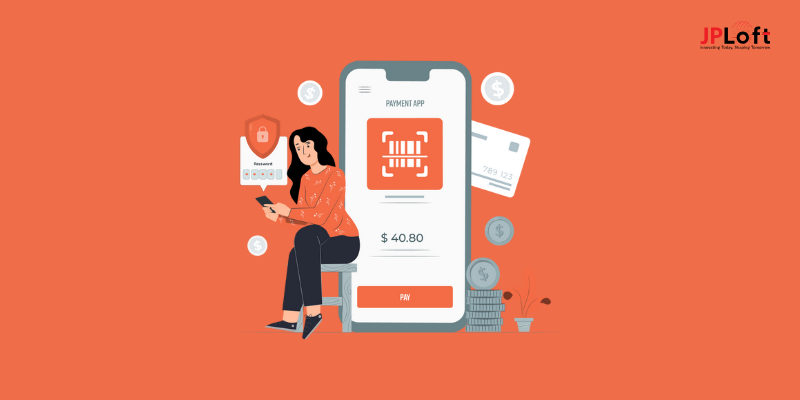eWallets have become a vital tool in the digital landscape and revolutionized how people manage their finances. Traditional payment methods are now being replaced by digital alternatives that offer a convenient and efficient platform for sending and receiving money.
This introduction delves into the "Top 10 eWallet Apps," providing insight into key players that have revolutionized financial technology.
As cashless transactions increase in demand, eWallet Apps have become essential components of daily life, catering to a diverse group of users looking for quick and effortless payment experiences. From established giants like Paypal and Mastercard to startup companies offering unique features with user-friendly interfaces and stringent security protocols - the market offers plenty of eWallet solutions with unique offerings from established giants and emerging startups.
At this critical juncture in the digital financial revolution, eWallet app development companies play a vital role in crafting innovative solutions to meet user and industry requirements.
As competition intensifies, eWallet app Development Company is pushing the boundaries of innovation to enhance these applications' functionality, security, and user experience.
Types of eWallet Apps
Explore various eWallet applications and their significance within Mobile Application Development Services.
Mobile Wallets:
Mobile wallets are among the most widely utilized types of eWallet Apps. Specifically developed to work on smartphones and tablets, mobile wallets enable users to store payment details safely while making transactions swiftly - examples being Apple Pay, Google Pay, and Samsung Pay.
These applications utilize Near Field Communication (NFC) technology for contactless payments, making in-store transactions swift and secure. Mobile wallets showcase how seamlessly financial services and mobile app development integrate, offering users one-stop solutions to meet all their payment needs.
Online Wallets (web wallets):
Web wallets provide users with easy and flexible eWallet solutions through web browsers, users can use these wallets from a computer desktop browser, mobile browser, or any combination thereof for managing finances across different devices.
PayPal and Skrill are famous examples of secure online wallets that facilitate secure online transactions, while mobile app development services often create web-based interfaces for these wallets to ensure consistent and user-friendly experiences across platforms.
Closed Wallets:
A "closed wallet" refers to an electronic wallet limited by ecosystem or platform and associated with one particular brand, retailer, or service provider - typically found within sectors like retail, where businesses provide payment solutions tied directly to products and services offered for purchase.
Starbucks uses mobile app development services extensively in creating its closed wallet system that enables customers to purchase products and redeem rewards through the Starbucks app. As part of their development and maintenance processes, these systems must also meet specific brand-related needs - something mobile app development services excel at.
Semi-Closed Wallets:
Semi-closed wallets offer the ideal combination between open and closed systems. Specifically, users may conduct transactions within an established network of merchants and service providers while being able to withdraw cash or transfer it directly into their bank accounts for added flexibility and use.
Paytm, an extremely popular eWallet in India, is an example of a semi-closed wallet that enables its users to make payments to merchants while transferring funds between bank accounts and mobile wallets. Developing semi-closed wallets involves complex integration between banking systems and mobile application development services to ensure seamless user interoperability.
Cryptocurrency Wallets:
As more countries shift toward digital currencies, cryptocurrency wallets have gained increasing traction as an indispensable way of securely managing and storing one or more cryptocurrencies, such as Bitcoin or Ethereum. They play an essential role in today's decentralized financial landscape.
Mobile app development services have taken advantage of this niche by designing user-friendly cryptocurrency wallets, making navigating blockchain technology more straightforward for individuals.
Government-Backed Wallets:
Many governments are exploring digital wallets to promote cashless economies and enhance financial inclusion for citizens. Government wallets provide secure ways for constituents to receive benefits or subsidies and conduct various transactions securely.
Also Read: How To Develop an ewallet App Like Venmo
Top 10 eWallet Apps
These top eWallet Apps in the US highlight features, security measures, and how they're changing the digital transaction landscape.
1. Apple Pay:
Apple Pay is one of the pioneering eWallet services on the market and stands out for its seamless integration across Apple devices, offering users seamless checkout on iPhones, iPads, Apple Watches, Mac computers, and even other web services.
Using tokenization technology ensures that sensitive information isn't stored during transactions for maximum protection - giving Apple Pay its unique competitive edge over rival wallets in this sector.
2. Google Pay:
As part of tech giant Google's product suite, Google Pay provides users with an accessible platform for making payments in various forms - in-store, online, peer-to-peer transfers, etc - regardless of location or payment method.
Supported cards and bank accounts make for seamless digital experience integration into other company services, while encryption and two-factor authentication provide user protection and prioritize user security.
3. PayPal:
With an impressive global footprint, PayPal has quickly become one of the go-to online payment services. PayPal's buyer and seller policies provide a safe environment for online transactions. Users can use their PayPal balance to pay or cash.
4. Samsung Pay:
Samsung Pay stands out with its innovative use of Magnetic Secure Transmission (MST) technology to enable payments even on traditional magnetic stripe card readers compared to some competitors. Furthermore, biometric authentication and Samsung Knox security measures help secure user information within this app.
5. Cash App:
Cash App has quickly gained prominence for its user-friendly and straightforward user experience, enabling users to link debit cards and send money securely and conveniently between friends and family or to pay for goods and services. Users also benefit from Cash Card: a customizable debit card tied directly to an App balance that offers discounts at various merchants with its "Boosts" feature.
6. Venmo:
Venmo is a subsidiary of PayPal that appeals to younger demographics by creating an interactive social experience around financial transactions. Users can share payment updates with friends and add emoticons or notes when making transactions through Venmo. In addition, Venmo supports iOS and Android operating systems for easy user transfers.
7. Zelle:
Zelle is an online peer-to-peer payment service partnered with central banks for seamless fund transfers. Unlike most eWallets, Zelle works directly within participating bank apps so users can send money without using an individual wallet app, this ensures wide user adoption while streamlining transaction processes.
8. Square Cash:
Square Cash is designed for seamless money transfers between users. They can link their debit cards directly with the app to facilitate easy money transfers or requests. Furthermore, users can access stocks and Bitcoin investments within this platform for increased functionality beyond typical peer-to-peer transactions.
9. Chase Pay:
JPMorgan Chase offers Chase Pay as their digital wallet app, it integrates securely and efficiently with Chase credit and debit cards to provide users with a smooth payment experience and special promotions and discounts when used at participating merchants.
10. Walmart Pay:
Walmart Pay is designed exclusively for customers of the retail giant Walmart and allows users to easily link credit or debit cards and make in-store transactions more straightforward. Furthermore, this app integrates with Walmart's loyalty program, giving users access to savings and benefits far beyond the shopping experience alone.
Read More: What are the Challenges Of Developing an eWallet Apps
The Future of eWallet App Development Trends
Current and emerging eWallet app development trends that promise to revolutionize how money is handled digitally are predicted to transform how we do so in future years.
Contactless Payments and NFC Technology Integration
One of the hallmarks of modern eWallet app development is contactless payments using Near Field Communication (NFC). Users can complete transactions simply by tapping their smartphones against compatible terminals to achieve them.
NFC technology will enrich user experiences and address hygiene concerns in an ever-more-hygiene-conscious society post-pandemic. NFC-enabled wallet apps should become even more widely adopted globally for quicker and simpler payment solutions for users worldwide.
Biometric Authentication to Increase Security
App developers constantly look for new ways to enhance the security of data. Biometric authentication is one option.
Integrating biometric authentication into eWallet Apps boosts security and expedites authentication processes - making transactions faster and simpler for the end-user.
Blockchain for Decentralized Transactions
Blockchain technology is a hot topic among eWallet designers. The decentralization of technology increases security and transparency while reducing fraud risks.
Integrating blockchain technology into eWallet Apps can also significantly lower transaction costs and processing times, thus making them increasingly attractive as demand for decentralized and secure financial transactions increases. As demand rises for such financial instruments, blockchain-enabled eWallets should become increasingly sought after.
Leveraging Artificial Intelligence for User Engagement
Artificial Intelligence (AI) has quickly become the focal point of eWallet app development, offering personalized experiences for users through AI algorithms that analyze behavior patterns such as spending and preferences to provide tailored recommendations and promotions specifically for them.
Personalization strengthens user engagement and contributes to an intuitive and user-friendly interface. As AI advances, eWallet Apps may become even better at anticipating user needs and providing seamless financial experiences tailored to individual needs.
Integrating Augmented Reality to Enhance User Interfaces
AR is quickly emerging as an innovative solution in eWallet app development, providing users with a futuristic yet immersive user experience. By superimposing digital information onto real-world surfaces using smartphone cameras, AR enhances eWallet Apps' user interfaces significantly.
Users could, for instance, visualize their transaction history or gain real-time updates regarding nearby deals and discounts through AR overlays. As AR technology becomes more sophisticated, its integration into eWallet Apps should redefine how users interact with digital finances.
Internet of Things (IoT) Connectivity for Seamless Transactions
The Internet of Things (IoT) has grown beyond smart homes and connected devices into eWallet app development, where IoT allows seamless transactions by linking eWallets with multiple smart devices, users could make payments directly using smartwatches, cars, or refrigerators!
Integration streamlines payment procedures, offering exceptional convenience and versatility. As IoT adoption increases, eWallet Apps may become critical to our interlinked digital ecosystem.
Multi-Currency Support for Global Transactions
As our globalized world becomes ever more interdependent, the need for multi-currency eWallet Apps that support different currencies continues to expand exponentially. Travelers and businesses engaging in cross-border trade require apps capable of safely and seamlessly handling foreign currencies.
Multi-currency support enables users to complete transactions using their preferred currency without incurring cumbersome currency conversion fees - an approach that not only facilitates international financial interactions but also caters to an increasingly global nature of interactions in finance.
Enhancing Security Measures with Two-Factor Authentication (2FA)
With cyber threats becoming ever more frequent, eWallet app developers are taking additional precautions against possible hacks, Two-Factor Authentication (2FA) adds another level of protection by mandating two forms of identification before accessing their eWallet accounts.
Two-factor authentication (2FA) or 2-factor verification could involve passwords, biometric data, or temporary codes sent directly to register mobile phones of users requiring financial data security. With more emphasis on protecting financial assets than ever, widespread adoption of 2FA in eWallet Apps should follow soon after.
Understanding eWallet App Development Cost: Factors and Considerations
Factors Affecting EWallet App Development Costs (FIEDCs): These factors contributing to eWallet app development costs are essential to consider when starting this digital journey.
#Factors Influencing eWallet App Development Cost:
Below are the factors influencing eWallet app development cost:
Features and Complexity of an EWallet App:
An eWallet's features can be critical in its development cost, from account creation, fund transfers, and transaction history to more intricate capabilities like multi-currency support or loyalty program integration. These additional functionalities often add complexity that adds significant expense in terms of development cost and complexity for user onboarding.
Security Measures:
Financial applications depend heavily on secure operations to operate successfully and to build customer trust among users while safeguarding sensitive financial data. Implementing robust security measures - encryption, secure authentication, and compliance with industry regulations - adds cost.
However, advanced features must also be available to build user confidence while protecting sensitive financial data from loss and theft.
Cross-Platform Compatibility:
Selecting the platforms where an eWallet app will be developed affects its cost, with native app development for both Android and iOS often more costly than developing cross-platform using frameworks like React Native or Flutter, ensuring greater reach but may need further optimization to reach users more effectively.
Experience Design and User Interface (UI/UX Design):
Easy user experience design is paramount to an eWallet app's success, increasing engagement and satisfaction among its target demographic. However, designing such an appealing yet functional user experience comes at additional costs due to skilled designers required to ensure a positive user journey.
Integration with Third-Party Services:
EWallet Apps often integrate with third-party services like banking APIs, payment gateways, or identity verification systems, adding complexity and compatibility issues and ultimately contributing to overall development costs. Seamless integration is crucial to app functionality and user convenience.
Compliance and Regulation:
Financial applications are subject to rigorous regulations and compliance standards, making compliance with local and international financial regulations part of their development cost. Legal consultation, adhering to Know Your Customer (KYC) requirements, and data protection laws all play vital roles during development.
#Critical Considerations for eWallet App Development Cost:
Below are some essential considerations for eWallets app development cost:
Budget Planning:
Before beginning the development of any app or mobile game, an extensive budget plan is an absolute necessity. Prioritizing must-have features according to business goals helps efficiently allocate resources while finding the balance between a feature-packed application and budget constraints, which is paramount for ensuring its success.
Development Team:
Your choice of development team - in-house or outsourced - affects costs. Hiring experienced developers, designers, and security specialists contributes to overall app quality while incurring higher expenses, outsourcing to an established development agency may offer cost-cutting benefits.
Scalability:
Planning for future scalability is paramount when creating an app, as its design must accommodate possible user base growth and feature enhancements. Preparing for potential growth could reduce long-term costs associated with significant overhauls or redevelopment efforts.
Testing and Quality Assurance:
Testing should include rigorous quality assurance protocols to detect bugs or vulnerabilities within an app while allocating resources for thorough security testing, which is crucial in creating an eWallet with security, performance, and user acceptance features. Testing scenarios should cover security, performance, and user acceptance testing, as outlined here.
Conclusion
eWallet Apps have revolutionized digital transactions and have been integral in shaping this transformation, playing an essential role in our current era of financial transactions. Not only have eWallet Apps revolutionized how we deal with finances, but they've also become integral parts of our daily lives worldwide due to their convenience, security, and efficiency. Here is our Top Ten list.
These top eWallet Apps' success can be attributed to their innovative features, including seamless payment processes and robust security measures that protect user's funds, with mobile payments becoming an ever-increasing part of daily life, competition among eWallet Apps as well as pressure on mobile app development companies have intensified about providing cutting edge solutions.
Mobile app development companies have played an instrumental role in the continuous advancement and evolution of eWallet Apps, with their expertise in designing intuitive user interfaces, implementing advanced security protocols, and guaranteeing smooth user experiences being vital elements in these applications' success.
As demand for electronic wallet apps increases exponentially, mobile app development companies will play an instrumental role in shaping the digital transactions of tomorrow.
FAQs
1. What Is an EWallet App, and How Does it Work?
An electronic wallet (eWallet app) is a digital tool individuals and institutions use for securely storing, managing, and moving money through mobile devices. An eWallet connects directly with its users' bank accounts or credit/debit cards to facilitate secure mobile phone transactions.
2. Are eWallet Transactions Secure?
Electronic wallet transactions are very safe as these apps use encryption technology to safeguard user data and transactions. Furthermore, many eWallets offer additional layers of protection like biometric authentication or PIN codes to enhance security further.
3. Can I link multiple bank accounts with one eWallet app?
That depends on which eWallet app you choose - some allow users to link multiple bank accounts simultaneously, while others may limit users. Please review its features and settings to ascertain whether linking various bank accounts is supported within that particular eWallet application.
4. What type of transactions can I make using my eWallet?
EWallets support various transactions such as peer-to-peer money transfers, online and in-store purchases, bill payments, and international money transfers - these will all depend on which eWallet app you choose. Check with it beforehand about its specific capabilities!
5. Do merchants generally accept eWallet Apps?
EWallet applications are widely accepted by businesses, popular eWallet Apps often form partnerships with companies to facilitate smooth and safe online and physical store transactions.
6. How Can I Load Money into my eWallet?
If you want to deposit money into your electronic wallet, connecting your account with your credit/debit cards or bank is possible. However, some eWallets also allow for cash deposits or bank transfers.
7. Can an eWallet app work without internet connectivity?
A: In general, most eWallet applications require internet access for transactions. Some offer limited offline functionality that enables users to view their balance or use certain features without needing to be connected online.
8. Are there any fees associated with electronic wallet transactions?
Fee structures vary among eWallet Apps. While basic transactions often offer free service, some services, such as currency conversion fees, withdrawal charges, or premium features that come at a cost, may incur associated charges, consult their Terms for further details.
9. What should I do if my phone with an eWallet installed is lost or stolen?
Most eWallet providers provide security features like remote deactivation or biometric authentication that should protect against theft of an account, so immediately contact their customer support to report your loss so they can guide you towards safeguarding it as soon as possible.
10. Can an eWallet app help me perform international transactions, including currency conversion?
Yes. Many eWallet Apps support international transactions, including currency conversion. Before conducting cross-border transactions through any eWallet app, it is wise to check its terms and fees, as they may differ depending on which eWallet provider is used.











